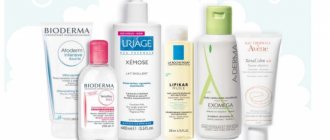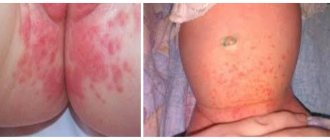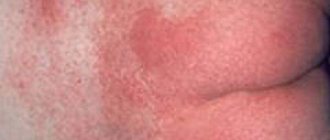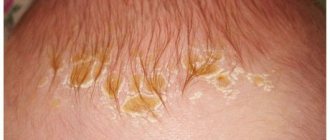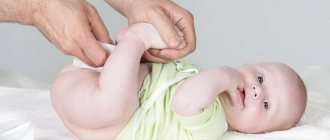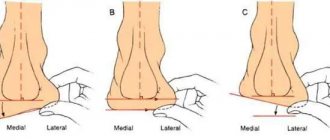The high prevalence of atopic dermatitis, especially in children in the first years of life, poses a serious problem for modern healthcare. The existing numerous methods of treating this disease do not always lead to a therapeutic effect, and therefore it becomes chronic and can recur in adults; severe forms of the disease cause psychological, social and economic damage to the family of the sick child.
Atopic dermatitis is a genetically determined allergic disease and is often associated with food allergies, bronchial asthma, allergic rhinitis, and gastrointestinal manifestations of allergies. Early onset of the disease and its combination with other allergic diseases are unfavorable prognostic signs. Significant progress in understanding atopic dermatitis, one of the most complex diseases of childhood, has been made by National and International programs devoted to this problem. Thanks to them, practitioners received guidance for timely diagnosis and prescription of rational and adequate treatment.
EPIDEMIOLOGY
Atopic dermatitis occurs in all regions of the world, in people of both sexes, in different age groups. The incidence, according to various authors, ranges from 6 to 15 people per 1000 population. In Russia, according to ISAAC, the prevalence of atopic dermatitis among children is 6.7%-12.3% of cases. Girls get sick more often (65%), boys less often (35%). The incidence of atopic dermatitis in cities is higher than in rural areas.
Every year in all regions of the country the number of patients will increase not only with a newly diagnosed diagnosis, but also with a more severe course of the disease, especially in early childhood. Children with atopic dermatitis are prone to subsequent development of bronchial asthma and allergic rhinitis.
CLASSIFICATION
Most countries, including Russia, have adopted a single term in accordance with the International Classification of Diseases, Tenth Revision (ICD-10) - atopic dermatitis (L20).
In 2001, the European Association of Allergists and Clinical Immunologists (EACCI) proposed the name Atopic Eczema/Dermatitis Syndrome (AEDS) to designate this disease. It can be allergic or non-allergic. Allergic SAED, in turn, is divided into IgE-mediated and IgE-non-mediated. However, this term has not found wide acceptance.
ETIOLOGY
Atopic dermatitis has a multifactorial origin (allergens, microorganisms, stress, irritants). In young children, the leading allergens are food products of animal and plant origin: cow and goat milk, chicken eggs, fish and seafood, legumes (peanuts, soybeans, peas, beans, lentils), grains (wheat, rye, barley, corn), fruits and vegetables, mostly red and orange in color (avocado, melon, grapes, strawberries, wild strawberries, peach, chestnut, persimmon, pomegranates, citrus fruits, kiwi, beets, carrots).
One of the first allergens that causes food allergies in children of the first year of life is cow's milk protein. In recent years, the number of serious allergic reactions (including anaphylactic shock) to peanuts has increased. It is often used in the manufacture of baked goods, sweets, and in Chinese and Thai dishes, and its addition to products is not always noticeable.
In older children, tick-borne, pollen and fungal allergens play a dominant role in the exacerbation of atopic dermatitis. Irritating chemicals, detergents, infections, emotional overload, and wearing tight clothing can cause an exacerbation of atopic dermatitis.
Causes of atopic dermatitis in children
Atopic dermatitis is not a skin disease. It is an external manifestation of internal problems of the body , signaling the insolvency of the baby’s gastrointestinal tract. The processes that take place during dermatitis can be described as follows: certain substances are not absorbed when they enter the body. After some metamorphoses, they become foreign to the body, and antibodies to them begin to be produced. This internal “confrontation” provokes the appearance of a rash (atopic dermatitis). Source: N.V. Yukhtina Modern ideas about atopic dermatitis in children // Issues of modern pediatrics, 2003, vol. 2, no. 1, pp. 74-76
The main factor in the development of the disease is heredity. If both parents have skin allergies, there is an 80% chance that the child will also have one. If one of the parents is sick, then the risk is 50%. And even with healthy parents, there is a 20% chance that the baby may develop AD.
In addition, the risk of developing AD in a child increases significantly if his expectant mother consumes a lot of allergens during the 6-9th month of pregnancy (strawberries, citrus fruits, chocolate, etc.). This causes antibodies to appear in the fetus, which then, when the baby is born, will react with allergens and cause a rash.
Features of the skin of children suffering from atopic dermatitis
The skin performs protective, thermoregulatory, excretory, respiratory, gas exchange and receptor functions. It consists of three main layers: epidermis, dermis and subcutaneous fat.
The epidermis is the outer layer consisting of keratinocytes, or epithelial cells. The epidermis consists of 4 layers: horny, granular, spinous and basal. The stratum corneum of the epidermis is very strong, elastic and relatively impenetrable. It is represented by keratinized cells, which turn into horny scales and slough off from the surface of the skin, and are then replaced by cells of the deep layers of the epidermis, which constantly divide, differentiate and mature as they move to the outer surface of the skin. In the stratum corneum, keratinocytes do not contain nuclei or organelles. They turn into corneocytes and are connected to each other by desmosomes and a “cementing substance,” which ensures the integrity of the epidermis. All this allows the epidermis to perform its main function - barrier, namely, skin protection.
Atopic dermatitis in children, treatment and origin
Keratinocytes are involved in the processes of allergic immune inflammation observed in atopic dermatitis. They can detect adhesion molecules (ICAM-1), the expression of which is almost always observed in the absence of HLA-DR. Expression of CD36, CD1a, and even IgE receptors can also be detected on keratinocytes from patients with atopic dermatitis, which indicates impaired cytokine production.
In addition to keratinocytes, the epidermis contains melaninocytes, Langerhans cells and Merkel cells. Melaninocytes are located in the basal layer of the epidermis and produce the pigment melanin, which protects the skin from ultraviolet radiation.
Langerhans cells are of bone marrow origin, have antigen-presenting function and carry out immune surveillance. In atopic dermatitis, they carry a high-affinity receptor for IgE on their surface, which is a highly specific phenomenon characteristic of this disease. Langerhans cells are considered the main cells responsible for IgE-mediated accumulation of allergens in the skin and their presentation to T cells. Their number in patients with atopic dermatitis is higher than in healthy people. Moreover, these cells have the same pathological phenotype and increased antigen-presenting activity. Increased expression of IgE receptors on Langerhans cells is seen as one of the main causes of skin damage in atopic dermatitis.
Merkel cells contact nerve endings, however, their function is not fully understood.
The surface of the epidermis, in addition to horny scales, is covered with a water-fatty mantle, which makes it practically impermeable to water and aqueous solutions. Fat-soluble substances penetrate better through the epidermis. This occurs due to the high fat content in cell membranes, and therefore fat-soluble substances dissolve in these membranes. About 60% of the lipids synthesized in the normal epidermis are phospholipids. They consist of sphingolipids, free and esterified sterols, free fatty acids and triglycerides. Patients with atopic dermatitis also have reduced levels of filaggrin, a precursor to the natural skin moisturizing factor. Pathological changes in the skin during atopic dermatitis disrupt its barrier function and lead to transepidermal fluid loss.
Atopic dermatitis in children
Diagnosis and symptoms of atopic dermatitis in children
The concept of “atopic dermatitis” is not very common outside medical circles. In common parlance, dermatitis is usually called diathesis ; in medicine, however, such a concept does not exist. At the same time, the stages of atopic dermatitis are distinguished: the earliest, infantile, which is called diathesis, childhood, and also adolescent-adult (late).
Infancy, the earliest stage, is the period up to 2 years. Red spots appear on the child’s skin, most often localized on the face (on the cheeks and forehead). Dermatitis occurs quite acutely: the affected areas become wet, swelling occurs, and crusts form. In addition to the face, other areas of the body (buttocks, legs, scalp) can also be affected by dermatitis. The acute stage is characterized by reddened skin and papular elements (skin bumps).
The period of exacerbation of dermatitis is characterized by the fact that papules and red spots mainly appear in the skin folds, behind the ears, on the surface of the elbow or knee joints. The skin becomes dry and begins to peel. Subsequently, the child develops a so-called “atopic face.” Increased pigmentation around the eyes, additional lining on the lower eyelid, and dull skin color characterize the “atopic face.”
If the stage of atopic dermatitis is not acute, then most often dermatitis manifests itself in the form of dry skin, as well as cracks in the skin on the back surfaces of the hands and in the fingers.
Complications of atopic dermatitis in children
Skin atrophy, along with the addition of pyoderma bacteria, in atopic dermatitis, are among the most common complications.
It is worth remembering that when treating atopic dermatitis, you should avoid scratching the skin, as it disrupts the barrier and protective properties of the skin, having a rather detrimental effect. Intense scratching can contribute to the development of microbial infections and fungal flora.
With pyoderma, pustules form on the skin, which dry out after some time, and crusts form in their place. Rashes can be localized in completely different ways. Pyoderma bacteria cause an increase in temperature and disruption of a person’s general well-being.
Another complication that occurs quite often with atopic dermatitis is a viral infection. Bubbles filled with clear liquid appear on the skin. This phenomenon is provoked by the herpes virus, which is the causative agent of the so-called cold on the lips. Such rashes often form in the area of inflammatory foci, but can also affect healthy skin or mucous membranes (oral cavity, genitals, eyes, throat).
Fungal infection is also a common complication of atopic dermatitis. Most often, the fungus affects the nails, scalp and skin folds. This is typical for adults. In childhood, the fungus most often affects the mucous membrane of the oral cavity.
Both bacterial and fungal infections can occur simultaneously.
Approximately 80% of patients who suffer from atopic dermatitis often develop bronchial asthma or allergic rhinitis. This usually occurs in late childhood.
Treatment of atopic dermatitis in children
When wondering how to treat atopic dermatitis, first of all, it is worth remembering that treatment should not be started on your own. To establish an accurate diagnosis and prescribe medications, you should consult a doctor. This is due to the fact that a number of serious diseases have symptoms very similar to dermatitis. Self-treatment can put the health and even the life of a child at risk.
Moreover, you should not independently extend the course of treatment with medications. Any medication has side effects, and even if they help to cope with the disease, if the treatment method is incorrect, these side effects can make themselves felt.
General principles or how to treat atopic dermatitis:
- – follow a hypoallergenic diet, eliminate the allergen;
- – take antihistamines that relieve itching;
- – detoxify the body;
- – use drugs that have an anti-inflammatory effect, for example, Thymogen – cream 0.05%
- – take sedatives (sedatives) (glycine, various sedative herbs, valerian, peony, etc.);
- – use antibacterial agents (if an infection occurs);
It should also be remembered that during exacerbation of dermatitis, treatment methods differ from those recommended for the normal course of the disease.
And remember that atopic dermatitis (AD) is a chronic disease that requires fairly long-term treatment, even if there is no exacerbation of the disease.
Hypoallergenic diet for atopic dermatitis in children
It is important to remember that only a doctor can make an accurate diagnosis and prescribe adequate treatment.
However, it is impossible to completely cure atopic dermatitis, since it is a chronic disease. However, there are methods and remedies that can reduce redness and eliminate itching. First of all, you should try to eliminate the allergen that may cause a negative reaction in the child.
Taking into account the degree of exacerbation of dermatitis, it is necessary to ensure careful care of the baby’s skin.
There may be cases when allergic inflammation occurs without obvious clinical inflammation, while the properties of the skin change. Skin moisture and permeability are the first to be affected. Medicinal cosmetics are very helpful in eliminating symptoms. The damaged properties of the skin are well restored with the help of fortified cosmetics.
A special diet plays an important role in the treatment of dermatitis. During periods of exacerbation, nutrition should be monitored especially carefully. You can soften the diet if there is no exacerbation of the disease.
Maintaining breastfeeding for as long as possible (at least 6 months) is a VERY IMPORTANT element for the health of the child. The mother should exclude foods that can cause an exacerbation of allergies from the diet.
It is important to bathe a newborn baby, as in the first year of his life, correctly. You cannot use soap. It is recommended to use specialized shampoos, or better yet, medicated ones.
Milk protein, eggs, fish, peanuts and soy are some of the most common allergens. It is important to remember that even if you are not susceptible to this, there is a potential risk of your child developing a food allergy.
At different ages, the manifestations of allergies are different. In the first or second year of life, food allergies clearly predominate in children.
In young children, treating food allergies is a rather complex process. During the feeding period, it is necessary to choose the right diet for the child and his mother - this is one of the main principles that helps treat atopic dermatitis.
Prevention of atopic dermatitis in children
In the prevention and treatment of atopic dermatitis, there are two main principles: creating a hypoallergenic environment to eliminate contact with allergens and, of course, following a special diet. If these principles are not followed, the effectiveness of treatment is greatly reduced.
In essence, creating a hypoallergenic environment is about maintaining a specific lifestyle. The main goal is to eliminate factors that could potentially cause skin irritation, thereby causing an exacerbation of dermatitis. To prevent atopic dermatitis and create a hypoallergenic environment, the following recommendations exist:
- – In the room, the air temperature should be maintained no higher than +23 °C, and the relative humidity should be no less than 60%.
- – It is recommended to take antihistamines that relieve itching;
- – Possible allergens must be excluded from food;
- – Feather, down pillows and wool blankets should be replaced with synthetic ones;
- – Sources of dust in the house should be eliminated (carpets, books);
- – You should wet clean the room at least once a week;
- – Particular attention should be paid to removing areas of possible mold formation (seams in the bathroom, linoleum, wallpaper);
- – Pets and plants should be isolated. It is necessary to exterminate insects (moths, cockroaches).
- – Pay attention to limiting or eliminating the use of various irritants (washing powders, synthetic detergents, solvents, glue, varnishes, paints, etc.)
- – Clothes made of wool and synthetic materials should only be worn over cotton ones.
- – You must not smoke in the house where the patient is.
- – Treatment with api- and herbal medicines is excluded.
- – It is worth limiting intense, excessive physical activity.
- – For bathing patients, you need to use weakly alkaline or indifferent soaps (lanolin, baby) or high-quality shampoos that do not contain artificial dyes, fragrances and preservatives.
- – When bathing, it is recommended to use soft cloth washcloths.
- – Using a softening, moisturizing neutral cream on the skin after a bath or shower is mandatory.
- – Stressful situations should be kept to a minimum.
- – Avoid scratching and rubbing the skin.
Holidays with a child with atopic dermatitis
A child who suffers from atopic dermatitis should not sunbathe - parents should remember this. A common mistake is to expose the patient to the sun for a long time. Despite the fact that this may lead to temporary improvements, in the future, a strong exacerbation of the disease is practically inevitable.
For patients with atopic dermatitis, the Azov Sea coast and other holiday destinations with a warm but dry climate are favorable.
Atopic dermatitis
The dermis—the skin itself—consists of skin appendages (hair follicles), sebaceous and sweat glands, blood vessels, nerves and collagen. The dermis has two parts: papillary and reticular. The papillary part consists of delicate fibers and a large number of blood vessels. The reticular (main) part contains a large amount of collagen fibers and a few blood vessels. The main cells of the dermis are fibroblasts, which synthesize an extracellular matrix consisting of collagen (70-80%), elastin (1-3%), proteoglycans and water.
Collagen gives elasticity to the dermis, elastin gives elasticity, proteoglycans retain water and form the main amorphous substance, resembling a gel, around collagen and elastic fibers, i.e. fill all the spaces between connective tissue fibers and cells. With their help, interstitial transport of all substances occurs.
Among the main functions of the dermis, thermoregulatory functions are distinguished (carried out by changing the amount of blood flow in the vessels of the dermis and sweating); mechanical (protection of underlying structures due to collagen fibers and hyaluronic acid) and receptor (due to nerve endings present in the dermis).
Subcutaneous fatty tissue consists of fatty lobules separated by fibrous septa. The latter includes collagen, blood and lymphatic vessels, and nerves. The body's energy reserve is concentrated in this layer of skin. The dermis also absorbs the energy of mechanical influences.
PATHOGENESIS
The pathogenetic basis of the disease is allergic inflammation and hyperreactivity of the skin, as well as a violation of the barrier function of the epidermis due to a genetically determined defect in the lipid metabolism of keratinocytes.
To date, quite a lot of data has been accumulated on the pathogenesis of immune inflammation of the skin in atopic dermatitis. It is based on Th2-dependent mechanisms. At the same time, type 2 T-helpers, through the production of interleukins (IL)-4, 5 and 13, stimulate the synthesis of immunoglobulins E, which are associated with the main manifestations of the early phase of immediate-type allergic reactions. Activation of mast cells and basophils during exposure to allergens leads to the release of biologically active substances (histamine, serotonin, tryptase, etc.), causing the development of the early phase of the allergic response with the occurrence of acute manifestations of atopic dermatitis. IL-4, IL-13, IL-9 support the proliferation of mast cells.
The subsequent development of allergic inflammation in the skin with atopic dermatitis is associated with the development of a late phase of the allergic response, during which the synthesis and secretion of anti-inflammatory cytokines IL-1, IL-6, IL-8, IL-5, granulocyte-macrophage colony-stimulating factor (GM- CSF), tumor necrosis factor, as well as hyperproduction of prostaglandins, leukotrienes, adhesive molecules, eosinophilic proteins. Exposure to these cytokines, mediators and adhesion molecules leads to skin infiltration by neutrophils, eosinophils, and mast cells.
There is some evidence indicating a leading role of T lymphocytes in the development of atopic dermatitis.
Atopic dermatitis: diet therapy
Drug and physiotherapeutic treatment are considered the basis of treatment for a disease such as atopic dermatitis. However, without correcting the patient’s diet, it will not be possible to get rid of the disease. Diet therapy is based on the following principles:
- exclusion from the diet of allergenic foods and histamine liberators (they contain elements that extract histamine from cells - the main factor in allergic reactions);
- eliminating the load on the liver, ensuring cleansing of the body from complications and consequences of allergies;
- providing the patient’s body with vitamins and elements that promote rapid skin regeneration;
- ensuring normal bowel function;
- keeping a food diary;
- decreased gluten intake as gluten tolerance decreases during allergies.
Each patient with atopic dermatitis is individually prepared with a special diet, taking into account the characteristics of the course of the disease, external provoking factors and area of activity. First of all, the patient must undergo several tests for allergenic foods, which are then excluded from the diet. If these tests have not been carried out, then all traditional allergens are excluded from the food.
- Meat and meat products: fatty pork, lamb, duck, goose and chicken (patients can eat rabbit, turkey and beef, preferring to stew or steam them).
- Fatty fish (trout, salmon, chum salmon, mackerel), mussels, crayfish, oysters, lobsters, crabs, caviar (you can replace them in the diet with pike perch, hake, cod).
- Fruits and vegetables: Replace orange and red varieties with white and green varieties. Melon, peaches, tangerines, oranges, persimmons, pomegranates, mangoes, strawberries, raspberries, wild strawberries, cherries, peppers, eggplants, beets, tomatoes, pumpkin are considered allergens. It is allowed to eat green pears, gooseberries, white cherries, plums and currants, cabbage, zucchini, potatoes, spinach, green peas, turnips.
- Cereals: white bread, semolina, pasta, and confectionery should be excluded from the diet. It is allowed to eat oatmeal and pearl barley. Buckwheat, bran bread, crackers, crackers.
- Dairy products are considered classic allergens that must be removed from the daily diet of a patient suffering from atopic dermatitis. You should not consume whole milk, cream, fermented baked milk, or cheese.
- Products that provoke the release of histamine: pineapples, strawberries, pork liver, chicken eggs, honey, coffee, chocolate, cocoa, alcohol, food additives (dyes, preservatives, flavor enhancers, flavorings) included in many semi-finished products.
- Products that put stress on the liver: margarine, confectionery fat, lard, strong tea or coffee, carbonated drinks, seasonings and sauces.
Correcting the patient’s diet involves not only excluding certain allergenic foods from it, but also introducing healthy foods into it. First of all, you need to add foods to your diet that will promote faster restoration of damaged skin. Omega-3 and omega-6 acids contained in vegetable oils cope most effectively with this task. For atopic dermatitis, it is useful to eat flaxseed, corn, sunflower, cedar and rapeseed oil as salad dressings.
With atopic dermatitis, disruption of the gastrointestinal tract is often observed, which is why the body's reaction to allergens becomes more pronounced and acute. Therefore, it is useful to introduce into the diet foods that ensure normal functioning of the gastrointestinal tract: stewed zucchini or cabbage, baked apples, yogurt, barley, oatmeal, pearl barley and buckwheat porridge. It is also worth considering that the body of a patient with dermatitis very poorly absorbs gluten, which is found in large quantities in wheat. That is why it is advisable to replace products made from wheat flour with those made from buckwheat, corn or oatmeal.
Nutritionists advise that if an allergy to a certain product is detected, not simply exclude it from the diet, but replace it with a similar, but more healthy one. For example, cow's milk can be replaced with goat's, sheep's or even vegetable (soy) milk, and chicken eggs with quail's. Doctors also put forward a number of requirements for the food preparation process:
- To cook potatoes, you must first soak them in cold water for a couple of hours so that all the excess starch comes out of the vegetable;
- since heat treatment of foods significantly reduces the likelihood of an allergic reaction to them, it is better not to eat raw vegetables and fruits;
- Cook porridge using the third broth - the first two need to be drained after the water boils;
- When cooking meat, you should also drain the first broth.
Diagnostics
Diagnosis of atopic dermatitis is based on clinical data. The examination includes a thorough history taking, assessment of clinical symptoms and assessment of the severity of the skin process, as well as an assessment of the degree of social and psychological maladjustment of the child and the impact of the disease on the patient’s family.
GENERAL PRINCIPLES OF TREATMENT
Therapy for atopic dermatitis is complex
and includes:
- elimination measures and diet;
- pharmacological agents that affect acute manifestations of the disease (symptomatic) and drugs that prevent relapse of the disease (anti-relapse);
- medications that normalize metabolism and reduce or eliminate deficiency of vitamins and microelements;
- external therapy;
- treatment of concomitant pathologies;
- educational programs for patients and parents of patients;
- Spa treatment;
- rehabilitation treatment.
Elimination measures and diet
Aimed at eliminating or reducing the impact of factors that provoke exacerbation of atopic dermatitis. The diet is selected individually, depending on the medical history and the results of an allergy examination. In addition to causally significant food allergens, meat, fish, mushroom broths, spicy, fried, canned foods, as well as nuts, chocolate, and citrus fruits are excluded from the diet.
Antihistamines, mast cell stabilizers
They are used during exacerbation of the disease and as anti-relapse treatment. Antihistamines of the “old” and “new” generations are used. In this case, antihistamines with a sedative effect are recommended for children with significant sleep disturbances caused by itching. The duration of the course of treatment with “old” generation H1 blockers is 10-14 days, while “new” generation antihistamines can be used for 2-3 months.
Prevention of atopic dermatitis in children
To date, risk markers for this disease have not been precisely established. Therefore, primary prevention - preventing the appearance of antibodies in the blood - is impossible.
Measures that parents can take are aimed at preventing the progression of the disease, complications, and relapses. These include:
- a special diet for a nursing mother, preventing allergens from getting into milk;
- monitoring the frequency of stools in the child and solving problems with the participation of a doctor;
- preventing the child from overheating, as sweat causes skin irritation;
- do not introduce two products into your baby’s diet at once, but wait a week after adding each new one to avoid a reaction;
- change diapers more often;
- Avoid contact with skin of synthetics and wool;
- use hypoallergenic hygiene products and washing powders;
- maintain a humidity of 40-45% and a temperature of 20-25°C in the baby’s room;
- do not vaccinate during exacerbations.
External therapy
External therapy is aimed at eliminating the inflammatory process in the skin, restoring damaged epidermis and improving its barrier function; improvement of microcirculation and metabolism in lesions, reduction of skin dryness; prevention and elimination of secondary bacterial or fungal infection.
The choice of external therapy is carried out differentially depending on the age of the child, the phase of the disease (acute or chronic), the severity of the disease (mild, moderate and severe), its period (acute, subacute and remission).
During the period of exacerbation (in the acute or chronic phase) of atopic dermatitis, external anti-inflammatory drugs are used. Among them, steroidal (topical glucocorticosteroids - TGCS) and non-steroidal anti-inflammatory drugs (zinc, naphthalan, tar, coal, pimecrolimus) are traditionally distinguished.
Topical steroids are the first-line treatment for atopic dermatitis, especially during exacerbation of the disease.
The main indications for their use are the development of severe exacerbations of atopic dermatitis and the ineffectiveness of other types of external therapy. Local use of corticosteroid drugs for 3-7 days can stop the inflammatory process in the skin and improve the general condition of the child.
The main requirements for topical drugs: high anti-inflammatory activity, rapid relief of subjective symptoms of the disease, ease of use that does not limit social and professional activity, maximum safety. In cases where traditional external therapy does not bring the desired effect, a worthy alternative is the administration of topical steroids, subject to the correct choice and application technology, especially in young children. Thus, in severe cases of atopic dermatitis, it is more advisable to prescribe topical glucocorticosteroids than systemic ones. The variety of forms of topical medications (cream, ointment, aerosol, lotion, emulsion) allows you to choose the most effective external remedy in each specific case.
When treating the skin of the face and scalp, it is better to use dosage forms in the form of lotions and aerosols without traditional fat content. They penetrate deeper into the dermis less well, which significantly reduces the possibility of side effects. An increase in the concentration of the corticosteroid in the drug also affects its penetration deep into the skin, which plays a particularly important role when using occlusive dressings. In children under 6 months of age, short courses of drugs with only weak activity (hydrocortisone acetate, hydrocortisone butyrate) are used, and in children over 6 months of age, non-fluorinated topical drugs of the new generation are used - methylprednisolone aceponate, mometasone fuorate, hydrocortisone butyrate. Each of these drugs has its own specific indications for use depending on the age of the child, the period, severity, localization and severity of the inflammatory process.
An absolute contraindication for the prescription of glucocorticosteroids is skin damage caused by tuberculosis or syphilitic infection, as well as skin rashes of viral etiology (varicella, shingles, etc.). For some lesions (acne, rosacea, a number of fungal diseases), these medications can cause worsening. The choice of glucocorticosteroid drug should be determined by the best risk-safety index, i.e. the ability to have a strong and rapid anti-inflammatory effect, have low systemic bioavailability and minimal side effects. The use of a rational classification of topical steroids can help solve the problem of choice. The maximum permissible area of skin treated with TGCS should not exceed 20% of the body surface. In children, especially young children, it is advisable to use topical medications with minimal penetration into the skin (emulsion, lotion, cream).
With prolonged and irrational use of TGCS, especially fluoride-containing drugs, side effects may develop: skin atrophy in the form of diffuse thinning of the epidermis and dermis, stretch marks; dryness, flaking; acne, folliculitis, blackheads; perioral dermatitis; telangiectasia; purpura; hypopigmentation; hypertrichosis; slowing down skin reparative processes; addition or exacerbation of infectious skin diseases - bacterial, viral, fungal; allergic or irritant contact dermatitis.
Skin irritation reactions (redness, burning, pain) in most cases are caused by the presence of ethylene glycol in the drug, and allergic contact dermatitis can be caused by the filler, preservative, flavoring or the steroid itself. The severity of the systemic effect of local glucocorticosteroids depends on the degree of their binding in the blood serum to the transport protein transcortin and the metabolic rate.
Fourth generation TGCS, which do not contain fluorine atoms in their structure, have an insignificant percentage of absorption, therefore, with short-term use, there are no systemic side effects.
It should be remembered that in young children it is undesirable to use glucocorticosteroids under occlusive dressings and prescribe fluorinated TGCS!
Emollients used between CS treatments help to moisturize the skin, which increases the effectiveness of therapy.
If topical steroids become ineffective, the course of treatment should be interrupted for a week or more, replacing them with simple emollients during this time, after which the effectiveness of the steroids is restored. THCS and emollient ointments should be applied no later than 3 minutes after the bath, while the skin is still wet - this enhances the softening effect.
To overcome “steroid phobia”, training patients and their parents in allergy schools is of great importance.
The correct tactics of prescribing local glucocorticosteroid therapy can minimize unwanted side effects and successfully control the symptoms of the disease.
Treatment of atopic dermatitis in children
Atopic dermatitis can be permanent. You may need to try multiple treatments over several months or years to control the disease. Even if treatment is successful, signs and symptoms may reappear.
Early detection of the disease allows timely treatment to begin. That is why, when primary symptoms appear, you need to contact an allergist-immunologist or dermatologist.
If regular moisturizing and other personal hygiene measures do not help, your doctor may suggest medication:
- Corticosteroid ointments. Relieve itching and help restore skin. Apply them according to the instructions after moisturizing the skin to avoid adverse reactions.
- Calcineurin inhibitors. Ointments are prescribed for ages 2 years and older. Affect the immune system. Avoid intense sunlight when using these products.
- Medicines to fight infection. Antibacterial cream is prescribed for bacterial infections, open sores or cracks. Oral antibacterial drugs may also be prescribed.
- Medicines to control inflammation. In severe cases, your doctor may prescribe oral corticosteroids.
Effective and intensive treatment for severe forms of the disease involves wrapping the affected area with topical corticosteroids and moist dressings. The procedure is performed under the supervision of medical professionals.
Phototherapy (light therapy) is prescribed to children whose condition does not improve with local treatment. The procedure involves exposure to a controlled amount of natural sunlight alone or in combination with medications.
Although effective, long-term phototherapy has detrimental effects, such as premature aging and an increased risk of cancer. For these reasons, phototherapy is not often used in young children and is not performed in infants.
Skin care products for children with atopic dermatitis
You must always remember that the skin of a patient with atopic dermatitis requires constant care. A very important element of skin care for such patients is the elimination or reduction of dryness, which causes a lot of inconvenience to both the sick child and his parents. To do this, it is necessary to carry out the following activities:
- ensure optimal humidity in the room where the sick child is located (at least 50%);
— do not prohibit swimming (for swimming, you must use non-chlorinated, cool water, preferably purified using special filters);
— as cleansers, use products specially designed for dry, irritated skin, enriched with plant and/or animal fatty acids and amino acids (they restore the physiological pH value of the skin and do not violate the integrity of the lipid layer of the epidermis).
Currently, care programs have been developed for skin prone to atopic manifestations, as well as for very dry skin using medicinal cosmetics.
Complications of atopic dermatitis: bacterial (vesiculopustulosis, pseudofurunculosis, staphylococcal impetigo, folliculitis, furunculosis, hidradenitis, streptococcal and slit-like impetigo, ecthyma, erysipelas, ulcers, paronychia); viral (herpes simplex, herpes zoster, Kaposi's eczema herpetiformis); fungal (intertriginous candidiasis, candidiasis of smooth skin, mucous membranes, corners of the mouth, interdigital spaces, candidal onychia and paronychia, vulvovaginitis, balanoposthitis), as well as mixed.
In case of bacterial complications of atopic dermatitis, combined topical preparations are used, which include a glucocorticosteroid and an antibiotic or antiseptic (Table 1).
Table 1
Combined drugs for external therapy for bacterial complications of atopic dermatitis
| Name of the drug | Active Ingredients |
| Medicines containing corticosteroids and antibiotics | |
| Celestoderm B with garamycin | Betamethasone valerate + gentamicin sulfate |
| Diprogent | Betamethasone dipropionate + gentamicin |
| Fucidin G | Hydrocortisone acetate + fusidic acid |
| Fucicort | Betamethasone + fusidic acid |
| Preparations containing corticosteroids and antiseptics | |
| Dermazolon | Hydrocortisone + chlorhexidine |
| Sibicort | Prednisolone + clioquinol |
For limited forms of fungal skin infections, only topical antimycotic agents are used (2% natsipicin cream, 1% clotrimazole cream). But monotherapy with antimycotic drugs does not control allergic inflammation and contributes to sensitization and exacerbation of atopic dermatitis. In this regard, it is advisable to use combination drugs containing antifungals and topical corticosteroids (Table 2).
Table 2. Combined drugs for external therapy for fungal complications of atopic dermatitis
| Name of the drug | Active Ingredients |
| Lotriderm | Betamethasone + clotrimazole |
| Candide B | Beclomethasone + clotrimazole |
In case of common forms of fungal infection and torpid course, systemic antifungal agents (fluconazole, itraconazole) and topical antimycotic agents should be used.
However, it must be taken into account that most complicated forms of atopic dermatitis do not have a single cause, but are the result of a combination of various mechanisms: bacterial infection, allergic processes and, often, hidden fungal infection.
In this regard, at present, the optimal means for relieving infectious complications in atopic dermatitis is the use of combination drugs, which include corticosteroids, antibacterial and antimycotic agents, which makes it possible to influence all parts of the pathological process (Table 3).
Table 3
Combined preparations for external therapy
for infectious complications of atopic dermatitis
Preparations containing corticosteroids, antimicrobial and antifungal agents
| Name of the drug | Active Ingredients |
| Triderm | Betamethasone + gentamicin + clotrimazole |
| Pimafukort | Hydrocortisone + neomycin + natamycin |
| Name of the drug | Active Ingredients |
| Triderm | Betamethasone + gentamicin + clotrimazole |
| Pimafukort | Hydrocortisone + neomycin + natamycin |
What is atopic dermatitis?
Atopic dermatitis is one of the most common allergic diseases, manifesting itself in severe form, affecting the skin. The disease dermatitis is genetically determined and, unfortunately, is chronic. The manifestations of atopic dermatitis are quite typical.
The main clinical symptom of atopic dermatitis can be considered itching. It occurs in all age groups.
The disease atopic dermatitis is a local manifestation of internal disorders in the immune system. When diagnosed with atopic dermatitis, first of all, treatment should be comprehensive and help normalize the general functions of the immune system. In this regard, a key role in the treatment of atopic dermatitis should be given to immunotropic drugs or, in other words, immunomodulators.
In medical practice, for the treatment of atopic dermatitis, the drug Thymogen has been used for several years, which is available in the form of a cream, nasal spray, and also in parenteral form. (Information on the use of Thymogen for specialists)
Although medicine has made huge strides in this area, the question of how to treat atopic dermatitis is still quite acute. The problem of treating dermatitis is serious and requires both the collaboration of the doctor and the patient, and the support of the patient from his family members.
